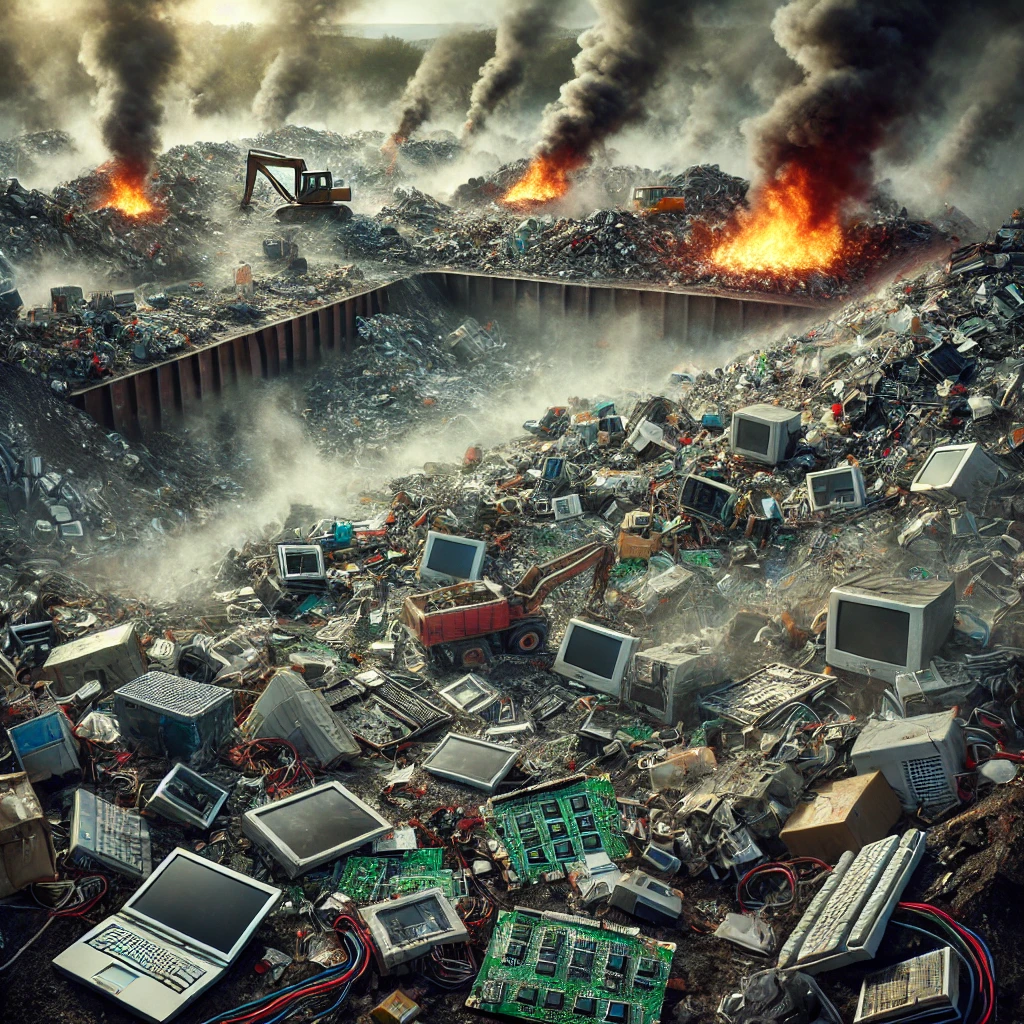The Hidden Dangers of Landfilling and Incinerating IT Assets: Why Reuse is Always Best

In today's world, managing electronic waste (e-waste) responsibly is more critical than ever. While recycling has become more common, many still landfill or incinerate their old IT assets. However, these practices have hidden dangers that can have significant environmental, health, and financial impacts. Let's explore these issues further.
The Problems with Landfilling E-Waste
Carbon Footprint of Landfilled E-Waste
Landfilling e-waste results in deceptively low direct carbon dioxide equivalent (CO2e) emissions from transportation and machines used in the landfill itself, resulting in net positive emissions of 0.02 metric tons of CO2e per short ton of electronics. However, this does not consider the raw materials that recycling recovers compared to landfilling, which recovers nothing. Given the massive amount of e-waste generated globally—62 million metric tonnes in 2022 alone—this can quickly add up to significant emissions in your Scope 3 emissions reporting.
Hazardous Waste and Environmental Pollution
E-waste constitutes about 2% of the US solid waste stream. However, carbon emissions are only a relatively small part of the problem with e-waste because it poses much more serious environmental risks than most municipal waste. This is because electronic waste contains numerous toxins, including heavy metals like lead, cadmium, mercury, and nickel, as well as organic compounds such as flame retardants, PFAS, and chlorofluorocarbons. When these toxins leach into the soil, water, and air, they pose severe risks to human health and the environment. If your old tech ends up causing environmental contamination, the Resource Conservation and Recovery Act holds companies liable for the clean-up costs, fines, and legal fees.
The Growing Ban on Landfilling E-Waste
Due to the increasing volume of electronic waste worldwide, expected to reach 81.6 million short tons annually by 2030, many countries are banning e-waste disposal in landfills. The USA is one of those countries. Here, 25 states and the District of Columbia have already strictly controlled or banned e-waste in landfills. Soon, it may be illegal nationwide to dispose of IT assets in landfills, making it crucial to find alternative solutions.
The Dangers of Incinerating E-Waste
Environmental and Health Risks
Incineration of e-waste, whether locally or in overseas informal recycling centers, poses significant environmental and health risks. The combustion process releases toxins like lead, mercury, and dioxins directly into the environment. Those toxins pose serious risks to human health at any level of exposure.
Carbon Footprint of Incinerated Electronics
Combustion of e-waste also releases large amounts of carbon dioxide, nitrous oxides, and other greenhouse gases. Electronics have a high carbon content, primarily in their plastic components, which are more often burned than recovered and converted almost entirely to carbon dioxide during combustion.
While incineration can recover some steel and generate energy, these offsets are minimal compared to the emissions produced, and not all incineration facilities recover the steel and energy. Overall, once you factor in potential energy generated and steel recovery, incineration still results in a net positive emission of 0.59 metric tons of CO2e per short ton of electronics, which adds to your Scope 3 emissions.
Why Reuse is the Best Option
Reducing Carbon Footprint
Reusing electronics significantly reduces carbon emissions compared to recycling and landfilling. When IT assets are reused, the need to manufacture new devices is avoided, whether from raw or recycled materials, cutting down on the substantial emissions associated with manufacturing and significantly reducing overall emissions.

Chart of the carbon emissions or reductions associated with reuse, recycling, landfilling, or incinerated old technology assets. Data from US EPA WARM.
Environmental and Social Benefits
Reusing IT assets keeps them out of landfills and incinerators, preventing the release of deadly toxins into the environment. It also extends the life of the devices, making technology accessible to those who might not be able to afford new equipment. This approach benefits the environment and society, promoting a sustainable circular economy and reducing the overall e-waste problem.
Turning ITAD into a Profit Center
A well-managed IT asset disposition (ITAD) process that prioritizes reuse can transform it from a cost burden into a profit center. By refurbishing and remarketing old assets, companies can recover value and reinvest it into their IT budget, all while contributing to environmental sustainability.
Case Study 1: ICT, an ITAD managed service provider (ITAD MSP), collaborated with a medical services company to securely dispose of 1,462 assets. They ensured 95% of the equipment was reused, and 5% was recycled with 0% landfilled, contributing to a circular economy, while the cost of the services was compensated for by the value of the equipment. Let ICT help your organization dispose of e-waste efficiently and sustainably.
Case Study 2: ICT has been working with a major pharmaceutical company and to date, Mission Reuse has helped earn the company $40,000 in positive cash flow they could put back into their IT budget.
Final Thoughts
Landfilling and incinerating IT assets pose significant environmental and health risks, contributing to greenhouse gas emissions and toxic pollution that threaten human health. Reuse, on the other hand, offers substantial benefits, reducing emissions, preventing pollution, and supporting a circular economy. By choosing to reuse IT assets, companies can make a positive impact on the environment and society, all while turning ITAD into a profitable and sustainable practice.
Find Out How We Can Help
If you are an enterprise, government, or institution looking for ITAD solutions or have additional questions, please contact us at ICT. Also, take a look at our in-depth white papers on ITAD Providers Recycling Services and Going Beyond E-Recycling How ITAD Minimizes Carbon Emissions for more information.
Selected References
ERCC. (n.d). Map of States With [E-waste] Legislation. Www.ecycleclearinghouse.org. https://www.ecycleclearinghouse.org/contentpage.aspx?pageid=10#:~:text=There are currently 25 states
ICT About ICT (n.d.) ICT About Company Page. Retrieved February 2, 2024, from https://ictcompany.com/
ICT Mission Reuse (n.d.) ICT Mission Reuse. Retrieved February 2, 2024, https://mission-reuse.com/
UNITAR. (2024). Global e-Waste Monitor 2024: Electronic Waste Rising Five Times Faster than Documented E-waste Recycling. https://unitar.org/about/news-stories/press/global-e-waste-monitor-2024-electronic-waste-rising-five-times-faster-documented-e-waste-recycling
US EPA. (2018, August 15). Summary of the Resource Conservation and Recovery Act | US EPA. US EPA. https://www.epa.gov/laws-regulations/summary-resource-conservation-and-recovery-act
US EPA WARM (2019) Documentation for Greenhouse Gas Emission and Energy Factors Used in the Waste Reduction Model (WARM) Electronics. US Environmental Protection Agency. https://www.epa.gov/sites/default/files/2019-06/documents/warm_v15_electronics.pdf
©ICT Inc. 2024-2027. All rights reserved. Unauthorized reproduction, distribution, or use of this article, in whole or in part, without proper attribution to ICT Inc. is strictly prohibited.
